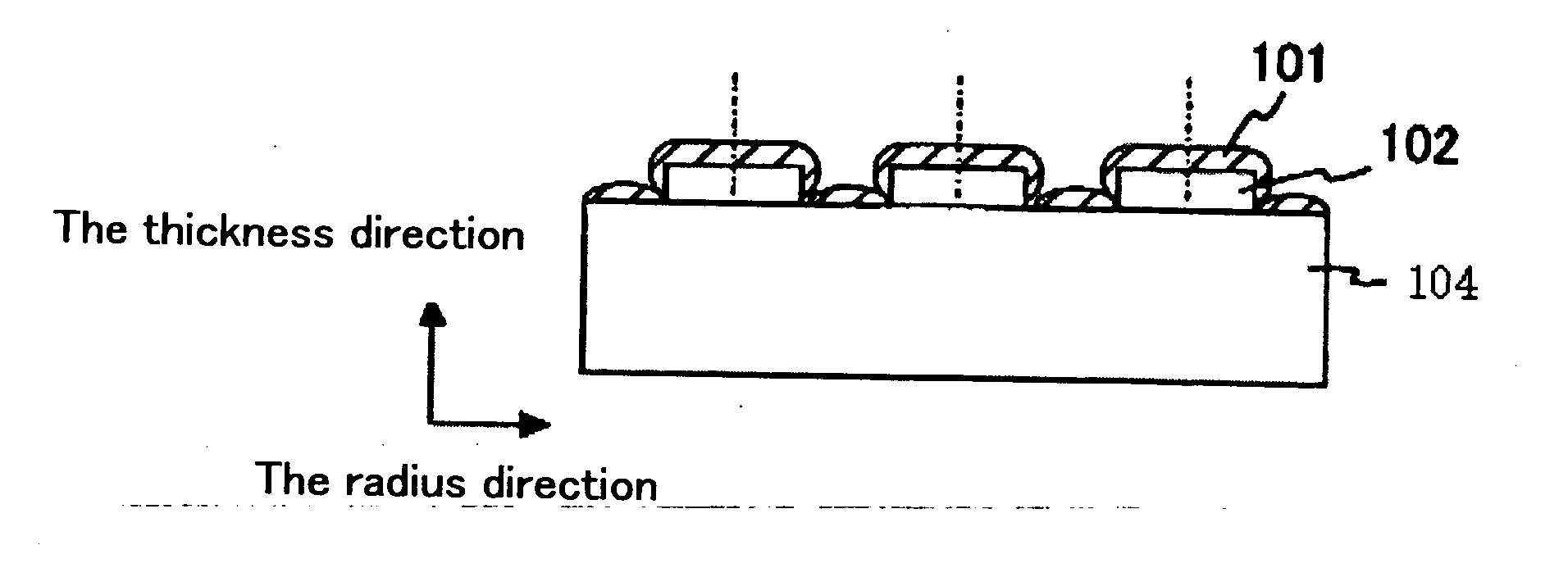Optical recording medium, and recording and reproducing method
- Summary
- Abstract
- Description
- Claims
- Application Information
AI Technical Summary
Benefits of technology
Problems solved by technology
Method used
Image
Examples
Example
Example 1 and Comparative Example 1
Preparation of Linear-Shaped Recording Part
[0147]FIGS. 8A to 8C respectively show a method for producing recording parts of an optical recording medium of the present invention, which are produced in accordance with the following examples.
[0148]FIG. 8A is a view showing a structure of an optical recording medium before the recording parts were processed in a linear form. The recording part 102 was made of ZnS—SiO2. For the composition ratio of the material, the material contained ZnS at 80 mole % and SiO2 at 20 mole %. The thickness of the recording parts 102 was 45 nm.
[0149] Light absorbing and heat generating part 103 was made of Ge, and the thickness thereof was 10 nm. Thermal conduction-suppressing layer 301 was made of ZnS—SiO2. For the composition ratio of the material, the material contained ZnS at 80 mole % and SiO2 at 20 mole %. The thickness of the thermal conduction-suppressing layer 301 was 50 nm.
[0150] Substrate 104 was made of po...
Example
[0157]FIG. 11 shows a structure of an optical recording medium produced in Comparative Example 1.
[0158] The reference numeral 1301 represents a recording part. The recording part was made of ZnS—SiO2—Ag. For the composition ratio of the material, the material contained ZnS at 70 mole %, SiO2 at 20 mole %, and Ag at 10 mole %. The thickness of the recording part 1301 was 45 nm.
[0159] The reference numeral 1302 represents a light absorbing and heat generating part. The light absorbing and heat generating part was made of AgInSbTe. For the composition ratio of the material, the material contained Ag at 4 atomic %, In at 7 atomic %, Sb at 61 atomic %, and Te at 28 atomic %. The thickness of the light absorbing and heat generating part 1302 was 20 nm.
[0160] The reference numeral 1303 represents a recording part. The recording part was made of ZnS—SiO2. For the composition ratio of the material, the material contained ZnS at 80 mole % and SiO2 at 20 mole %. The thickness of the recordi...
Example
[0162] The optical recording medium of Comparative Example 1 in which plural thin layers were formed in a laminar structure was compared to the optical recording medium of Example 1 shown in FIG. 10 by recording information on the respective optical recording media. The wavelength of the laser beam used in the recording was 405 nm, and the numerical aperture of the object lens was 0.85. FIG. 12 shows the comparison results. In FIG. 12, the reference numeral 1401 shown on the right side of the view represents a recording pulse. The laser power was modulated between the recording power level and the bias power level to record information. The recording period was 400 nm. The recording and reproducing linear velocity was 3.5 m / sec. The reproducing power was 0.2 mW. In FIG. 12, the reference numeral 1402 shown on the left side of the view represents changes in signal amplitude with respect to each recording power. The reference numeral 1403 represents recording results of the optical re...
PUM
 Login to View More
Login to View More Abstract
Description
Claims
Application Information
 Login to View More
Login to View More - R&D
- Intellectual Property
- Life Sciences
- Materials
- Tech Scout
- Unparalleled Data Quality
- Higher Quality Content
- 60% Fewer Hallucinations
Browse by: Latest US Patents, China's latest patents, Technical Efficacy Thesaurus, Application Domain, Technology Topic, Popular Technical Reports.
© 2025 PatSnap. All rights reserved.Legal|Privacy policy|Modern Slavery Act Transparency Statement|Sitemap|About US| Contact US: help@patsnap.com



